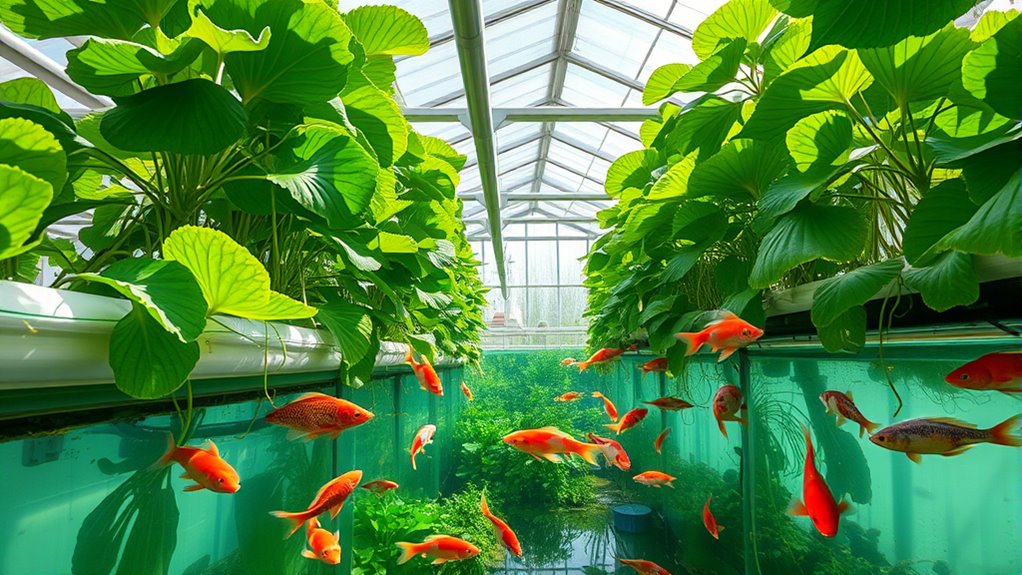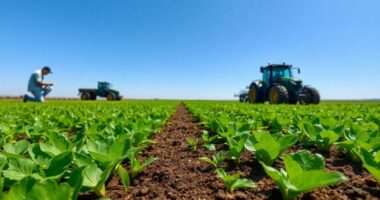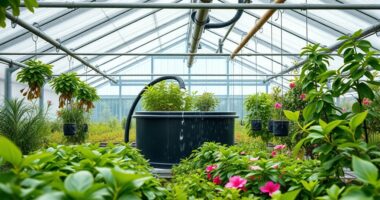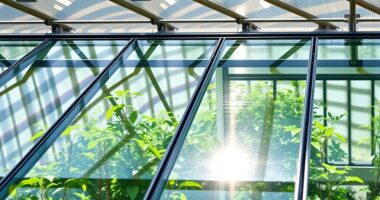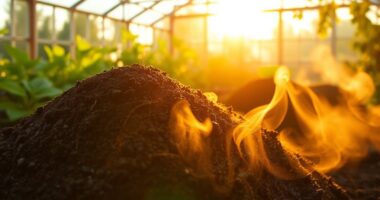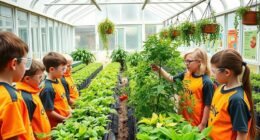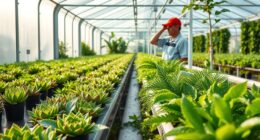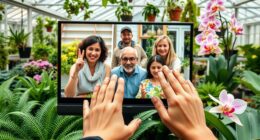Aquaponics combines fish and plants into a sustainable system where healthy fish produce nutrient-rich waste that fertilizes the plants. In turn, the plants help keep water clean, supporting fish health and reducing the risk of disease. By monitoring water quality and choosing the right plants, you create a balanced environment that benefits both. To discover more about how this eco-friendly cycle works, keep exploring the key factors behind its success.
Key Takeaways
- Aquaponics integrates fish and plants in a symbiotic cycle, promoting sustainable food production with minimal external inputs.
- Healthy fish produce nutrient-rich waste that naturally fertilizes plants, reducing the need for chemical fertilizers.
- Plants filter water by absorbing excess nutrients, maintaining water quality and preventing system imbalances.
- Regular monitoring of water parameters ensures optimal conditions for both fish health and plant growth.
- This eco-friendly system supports environmental sustainability by recycling waste into valuable resources.
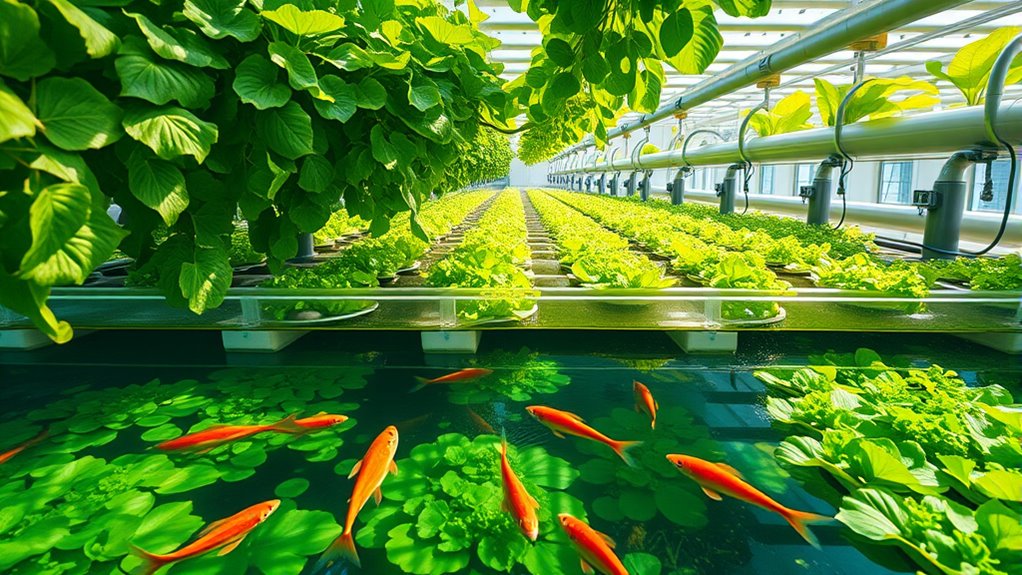
Have you ever wondered how you can grow fresh fish and vegetables simultaneously in a sustainable way? Aquaponics makes this possible by creating a balanced ecosystem where fish and plants thrive together. In this system, maintaining ideal fish health is essential because healthy fish produce the nutrient-rich waste that feeds your plants. When fish are stressed or unwell, their waste decreases in quality, which can lead to poor plant nutrition and stunted growth. Ensuring proper water quality, appropriate stocking densities, and regular monitoring keeps your fish healthy and your system running smoothly. This means checking parameters like pH, ammonia, nitrites, and nitrates regularly so that your aquatic creatures stay stress-free and disease-free. When fish are in good condition, they continuously produce waste that supplies critical nutrients for the plants, creating a sustainable cycle that minimizes the need for external inputs. Proper water quality management is crucial for balancing the entire system effectively.
On the flip side, your plants play an equally essential role in supporting fish health. As they absorb nutrients from the water, they help keep the environment clean and balanced, preventing the buildup of harmful substances like ammonia and nitrites. Healthy plants act as natural filters, which reduces the risk of fish illness caused by poor water quality. To maximize plant nutrition, you need to select the right plants for your system—those that are fast-growing and efficient at nutrient uptake, such as lettuce, basil, or herbs. Providing adequate light, maintaining proper water flow, and ensuring the right balance of nutrients are key steps for healthy plant growth. As plants flourish, they absorb excess nutrients, which helps prevent algae overgrowth and keeps the water clear. This symbiotic relationship means you don’t have to add chemical fertilizers, making your aquaponic setup more eco-friendly and sustainable.
In essence, the health of your fish and the nutrition of your plants are interconnected. When one suffers, the entire system can suffer. That’s why consistent care, monitoring, and adjustments are essential. By focusing on fish health, you secure a steady supply of nutrients, and by nurturing healthy plants, you maintain water quality and prevent disease. This dynamic balance exemplifies true sustainability—where waste becomes resource and life is interconnected. With dedication and careful management, aquaponics allows you to produce fresh fish and vegetables in a way that’s both environmentally responsible and rewarding. It’s a system that not only feeds your body but also promotes a healthier planet, demonstrating how nature’s cycles can work harmoniously when you pay close attention to every element.
Frequently Asked Questions
How Much Initial Investment Is Needed for a Small Aquaponics System?
You’ll need about $500 to $2,000 for a small aquaponics system, depending on your setup and goals. Start with cost estimation for equipment essentials like tanks, grow beds, pumps, and plumbing. Basic materials can be affordable, but investing in quality guarantees durability and better yields. Consider DIY options to cut costs, but remember that initial investment varies based on size, materials, and whether you buy new or used.
What Are the Common Challenges Faced by Beginner Aquaponics Growers?
As a beginner, you might face challenges like pest management and nutrient deficiencies. Pests can damage your plants, so stay vigilant and use natural controls. Nutrient deficiencies can stunt plant growth, so monitor water quality and add supplements if needed. You may also struggle with balancing fish and plant health, but regular testing and adjustments will help. Stay patient, learn from mistakes, and you’ll improve your aquaponics skills over time.
How Does Aquaponics Compare to Traditional Farming in Water Usage?
You’ll find that aquaponics uses substantially less water than traditional farming, making it a smart choice for water conservation. It recycles water continuously through the system, which means you’re maximizing resource efficiency. Unlike conventional methods that often waste water through runoff and evaporation, aquaponics keeps water within the system, reducing overall usage. This sustainable approach helps conserve essential resources while producing healthy plants and fish efficiently.
Can Aquaponics Systems Be Scaled for Commercial Production?
You can absolutely scale aquaponics systems for commercial production; it’s like turning a small spark into a blazing fire. By integrating urban spaces and utilizing renewable energy, you can create efficient, eco-friendly farms that meet high demand. This approach boosts urban integration, reduces transportation costs, and minimizes environmental impact. With proper planning and investment, aquaponics can revolutionize large-scale food production while promoting sustainability and resource conservation.
What Are the Best Fish and Plant Species for Beginners?
For beginners, you should choose hardy fish species like tilapia or goldfish, as they’re easy to care for and adapt well. When selecting plant choices, go with fast-growing, low-maintenance options such as lettuce, basil, or mint. These fish species and plant choices help you learn the basics of aquaponics without much hassle, making your experience more successful and enjoyable as you develop your skills.
Conclusion
Imagine your garden as a thriving symphony where fish and plants dance together in harmony. Just like a small backyard aquaponics system I saw transform a neglected corner into a lush oasis, you can turn limited space into a sustainable haven. With over 80% water reuse, aquaponics proves it’s possible to grow food efficiently and eco-friendly. Embrace this method, and watch your own little ecosystem flourish, proving that harmony between nature and innovation is within your reach.
